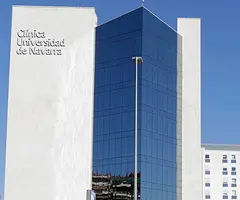Glioblastoma multiform
"For an immunotherapy treatment to be efficient, we use a fluorescent microscope in the operating theatre, which increases the percentage of tumorous tissue removed".
DR. JAIME GÁLLEGO
COORDINATOR. CENTRAL NERVOUS SYSTEM TUMORS AREA

Glioblastomas are tumors that arise from the supporting cells of brain tissue.
They can be primary tumors, which originate from the very cells that make up the various brain structures, or metastatic, which have spread to the brain from another extracerebral location. The latter are 10 times more frequent than primary brain tumors.
The Clinica Universidad de Navarra has a Central Nervous System Tumors Area which has a highly specialized team of experts and the most advanced technology for the diagnosis and treatment of glioblastoma.
We are the only Spanish center that incorporates high field intraoperative magnetic resonance imaging (3T). This allows the maximum precision and control in cranial surgery.
The Clinica has the series of patients with the highest average volume of glioblastoma removal. With the fluorescence microscope, complete removal is achieved in 83% of cases.
In addition, we are at the forefront of both treatment and research: we are the only Spanish center that carries out a study for the treatment of glioblastomas with immunotherapy through personalized vaccines combined with the standard first-line treatment.

A PERSONALIZED MEDICINE
Second Opinion,
peace of mind
Request a second opinion from our professionals with great experience in the diagnosis and treatment of oncological diseases
In 3 days, without leaving home.
What are the symptoms of glioblastoma multiforme?
Headache
Headache is the most common non-specific symptom. In many cases, it is difficult to suspect the presence of a brain tumour.
Drowsiness
Symptoms resulting from increased intracranial pressure, such as drowsiness, may be more indicative of the presence of a glioma.
Other
There are other more specific signs and symptoms that appear depending on the location of the disease, such as focal signs (loss of strength, slurred speech or visual field deficits), seizures and haemorrhage.
Do you have any of these symptoms?
If you suspect that you have any of the above symptoms,
you should consult a medical specialist for a diagnosis.
Prognosis of glioblastoma multiforme
Low grade I and II gliomas
- Good prognostic factors are:
- Being under 40 years of age.
- Tumour diameter less than 6 cm.
- Tumour does not extend beyond the midline.
- Oligoastrocytic histological type.
- Absence of neurological deficits.
- Survival in these patients with high-grade tumours ranges from 9 to 2 years depending on the prognostic group.
Gliomas III and IV
- Good prognostic factors are:
- Age (under 40-50 years).
- Be in good general condition with autonomy.
- Normal mental state.
- Achieve complete surgical resection.
- Survival in these patients with high-grade tumours ranges from 2 years to 6 months depending on the prognostic group.
What causes glioblastoma multiforme?
The exact causes of uterine cancer are not known. The risk increases if there are chronically high oestrogen levels and the woman is past menopause.
Predisposing factors include obesity, a history of infertility or lack of pregnancy, late menopause (over 52 years of age), polycystic ovary syndrome, ovarian tumours that produce oestrogen, or use of oestrogen-containing hormones (e.g. hormone replacement therapy without added progesterone).
The most common hereditary syndromes associated with endometrial cancer are Lynch syndrome, Cowden syndrome and hereditary breast and ovarian cancer associated with BRCA1/2 mutations.
If there is a history of uterine cancer in a family, it is advisable to consult a specialist in Clinical Genetics to carry out the necessary tests and find out if there is a hereditary component.
How is glioblastoma multiforme diagnosed?
MRI shows the brain lesions, their size and location. With sophisticated sequences and PET with methionine, the type of tumour is pinpointed. This information is transferred to navigation devices in the operating theatre.
Biopsy
Tissue analysis by a neuropathologist is key to diagnosing the type and grade of tumour. It can be obtained by open surgery or image-guided (stereotactic) puncture.
Plasma analysis
Allows detection of gliomas and their degree of malignancy when biopsy is not feasible.
Treatment for glioblastoma multiforme
The Clinic has the series of patients with the highest average volume of glioblastoma removal.
It uses a novel technique, the fluorescence microscope, which achieves the complete removal of the glioblastoma in 83% of the cases. These data have been published in international scientific journals.
In general, if the entire tumor part is removed, grade 1 and some grade 2 tumors can be cured by surgery alone.
In low-grade tumors that cannot be completely operated on and in grade 3 and 4 tumors, surgery should be followed by radiation and chemotherapy treatments.
Chemotherapy has been shown to be effective in prolonging survival in high-grade gliomas.
The current standard is to use temozolomide at the same time as radiotherapy and at least 6 cycles later.
In addition to this standard treatment, there are other options for which new data are emerging every year. The use of these second lines, whose use is more complex, depends on each case and the experience of the oncologist.
In spite of all the treatments, in many cases of high grade gliomas or glioblastoma the progression of the disease is not stopped, that is why it is important to continue studying with basic research and clinical trials.
Precision in the planning and execution of radiation therapy is essential to ensure that the maximum dose is delivered to the tumor, while preserving normal tissues.
This accuracy depends on the specialist's experience and care in planning, the imaging tests available for planning, and the equipment available.
Innovative techniques are used such as three-dimensional conformal radiotherapy, beam intensity modulated radiotherapy, and stereotactic techniques that require state-of-the-art linear accelerators and significant computer support.
In high-grade gliomas, the treatment that has demonstrated the greatest survival is the combination of surgery, radiotherapy at a higher dose than in low-grade gliomas, and chemotherapy. The component of post-operative treatment that has shown the greatest benefit is radiotherapy.
La Clínica is the only Spanish center that carries out a study for the treatment of glioblastomas with immunotherapy.
The new therapy, which is administered to participating patients in the form of vaccines, is combined with standard first-line treatment. It consists of the surgical removal of the tumor, followed by the administration of radiotherapy and chemotherapy with temozolomide.
The immune system is critical in the development and control of tumors. Immunotherapy aims to repair or increase the response of the patient's immune system.
The limited amount of disease and the combination of chemotherapy and immunotherapy make this a good added option to the treatment of patients with glioblastoma.
What clinical trials do we have on glioblastoma?
Proton therapy for cancer
Proton therapy is the most precise external radiotherapy modality, providing better distribution of radiation dose and therefore less irradiation of healthy tissues.
The Proton Therapy Unit of the Cancer Center Clínica Universidad de Navarra in its Madrid headquarters is the most advanced in Europe and the first in a Cancer Center, with all its healthcare, academic and research support.
Where do we treat it?
IN NAVARRA AND MADRID
Central Nervous System Tumors Area
of the Cancer Center Clínica Universidad de Navarra
In the Central Nervous System Tumors Area we offer maximum safety and efficiency in brain tumor surgery, being the first hospital with a high field magnetic resonance within the operating room.
We have a highly specialized team in the surgery of brain tumors, with more than 15 years of experience.
The individualized treatment of each case by an interdisciplinary team allows us to offer the best alternative to each patient.

Why at the Clinica?
- Integral evaluation of the patient.
- Cutting edge technology.
- Expert professionals who are a national reference.



























